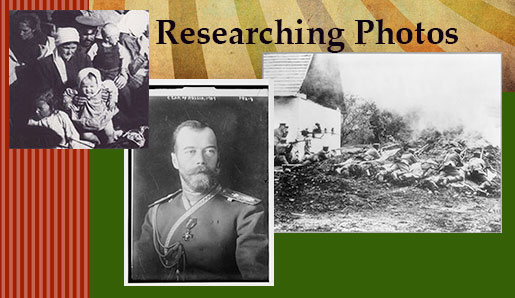 What’s interesting about photograph research is that the “good” photos aren’t always the “best” photos. I’m constantly searching for pictures readers haven’t seen time and again. I like snapshots – candid, unposed images – which is what made the Romanov research so much lengthier. The family took thousands of pictures of themselves doing the most mundane things – eating, doing homework, shoveling snow. They each had their own Brownie Box camera, even little Alexei, and they snapped along indiscriminately. The result was thousands of photographs, a seemingly endless visual documentary of their day-to-day lives. I had a hard time making final choices for the book. Often it came down to budget. What could we afford? I have to mention the generosity of Yale University here. Not only do they house a wealth of wonderful photographs, but also they are exceedingly generous about sharing them. You’ll note that most of the family photos found in the book came from Yale.
What’s interesting about photograph research is that the “good” photos aren’t always the “best” photos. I’m constantly searching for pictures readers haven’t seen time and again. I like snapshots – candid, unposed images – which is what made the Romanov research so much lengthier. The family took thousands of pictures of themselves doing the most mundane things – eating, doing homework, shoveling snow. They each had their own Brownie Box camera, even little Alexei, and they snapped along indiscriminately. The result was thousands of photographs, a seemingly endless visual documentary of their day-to-day lives. I had a hard time making final choices for the book. Often it came down to budget. What could we afford? I have to mention the generosity of Yale University here. Not only do they house a wealth of wonderful photographs, but also they are exceedingly generous about sharing them. You’ll note that most of the family photos found in the book came from Yale.
Pictures of ordinary Russians – peasants, workers, and soldiers – were far more difficult to come by. These were people living marginalized lives. Most couldn’t afford to have themselves photographed, nor would they have considered flitting away hard-earned money on such an expense. They certainly didn’t own cameras, or have the resources to develop film. This meant, of course, that they relied on outside chroniclers. So did I. Happily for all of us, Nicholas commissioned a photographer named Sergei Prokudin-Gorskii to visually document the empire. Produkin-Gorskii traveled the length of the country just before World War I, catching on film the ordinary lives of ordinary Russians. Best of all, he left those photographs – hundreds in all – to the Library of Congress. They’re heartrendingly beautiful. One can’t help but wonder if Nicholas ever saw them. But you can. The Library of Congress had digitized them and made them available online. Go take a look!
I look at photographs in two ways. The first, of course, is with a designer’s eye. How will this particular photo inform my reader? Can it do ‘double duty”? That is, can it illustrate more than one topic or theme? How will it look with the other photos? Does it add to the story? Will it draw young readers in? Does it provide an interesting juxtaposition? Will it provide a sense of visual continuity?
The second way is with a researcher’s eye. I search for details I can use in my narrative. I look closely at things like wallpaper patterns, and the lace trim on gowns. I note the backgrounds. Is that a fountain? Of what? Is that the mountains? Which ones? Oftentimes I even look with a magnifying glass. Is that mud on that peasant girl’s bare toes? Are the grand duchesses all wearing matching, gold bracelets? Ah, there must be a story behind that! As you can probably guess, I examine lots of photographs that I have no intention of including in the book. But discovering how things look from these primary sources is essential to telling an engaging story.

